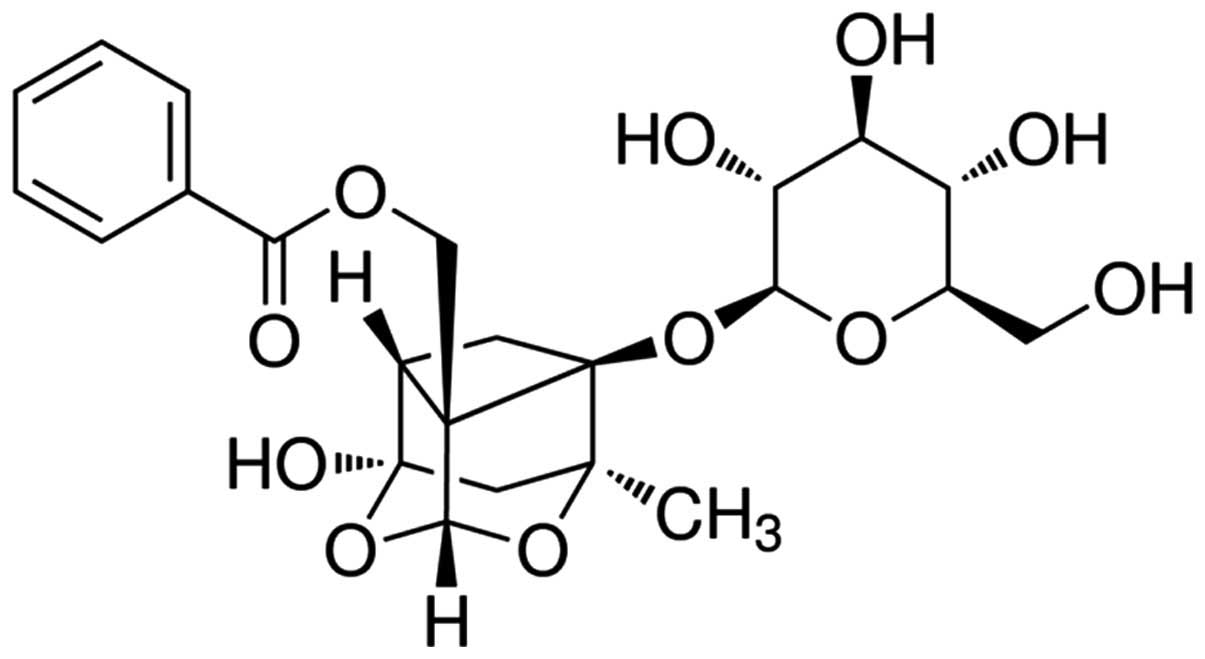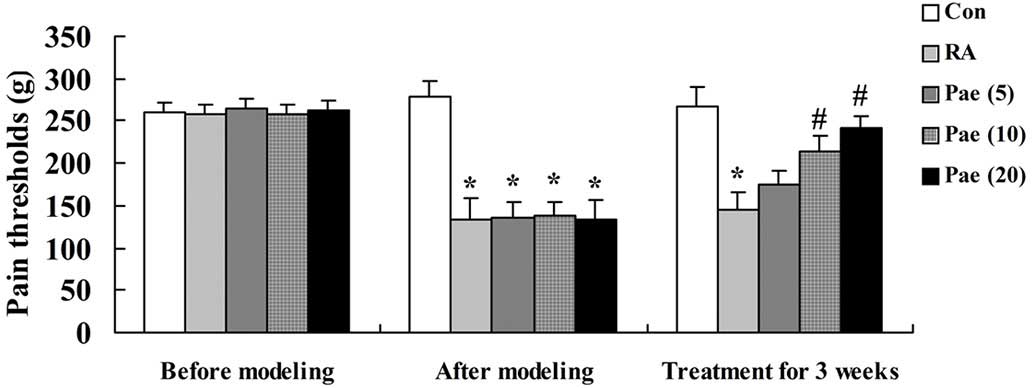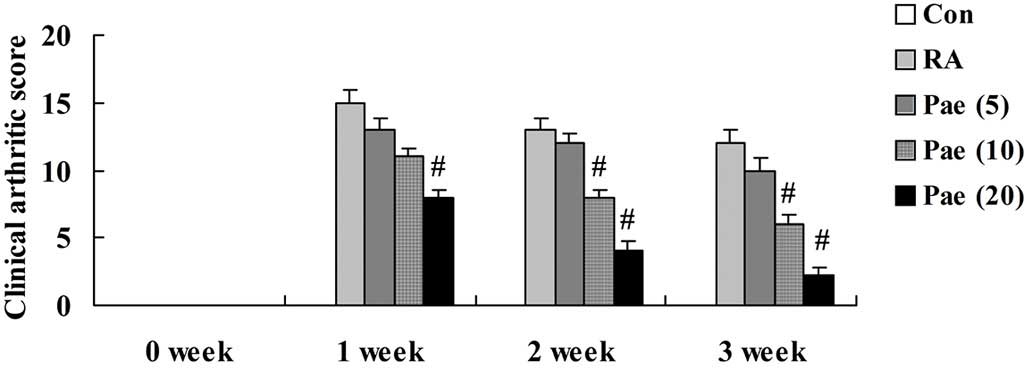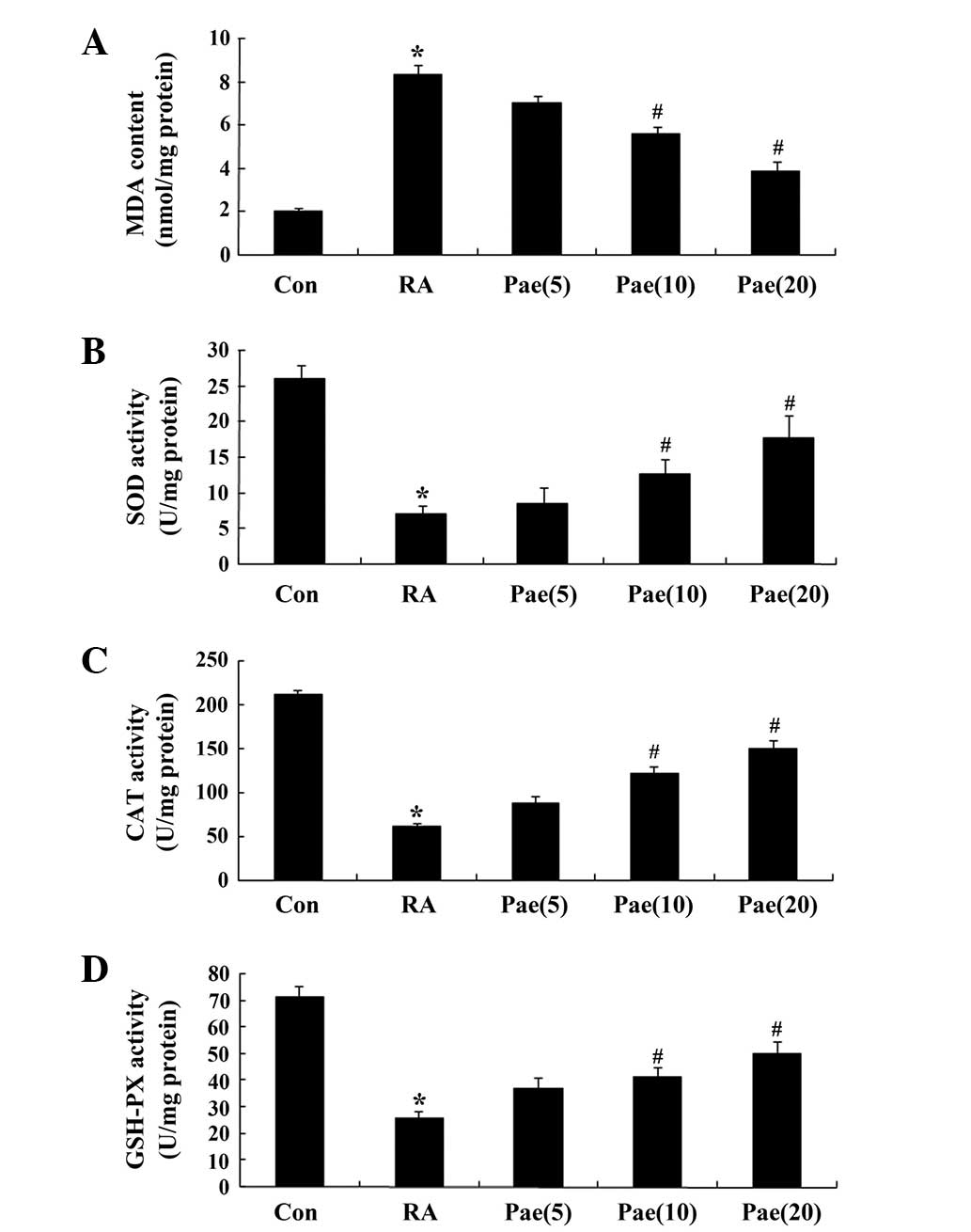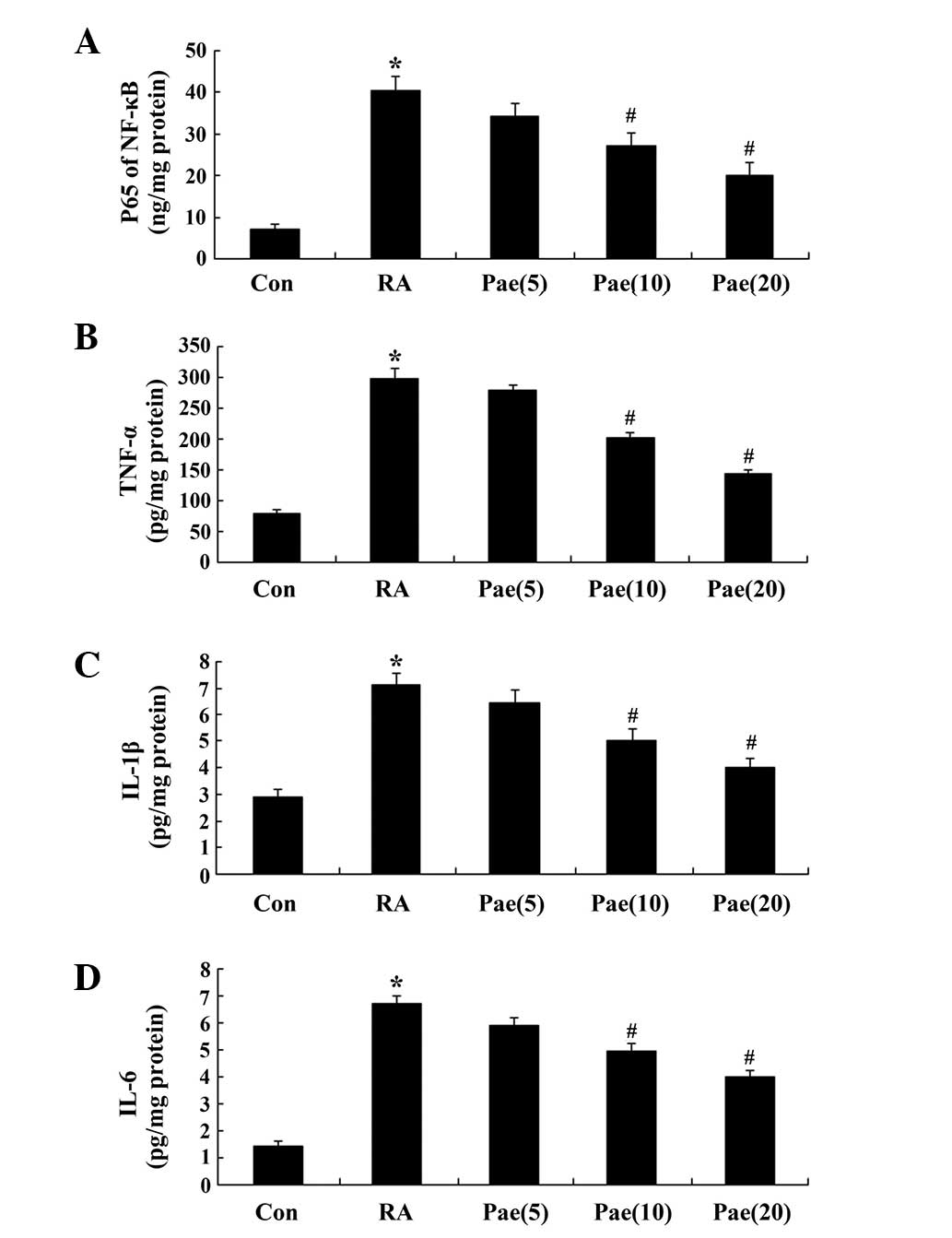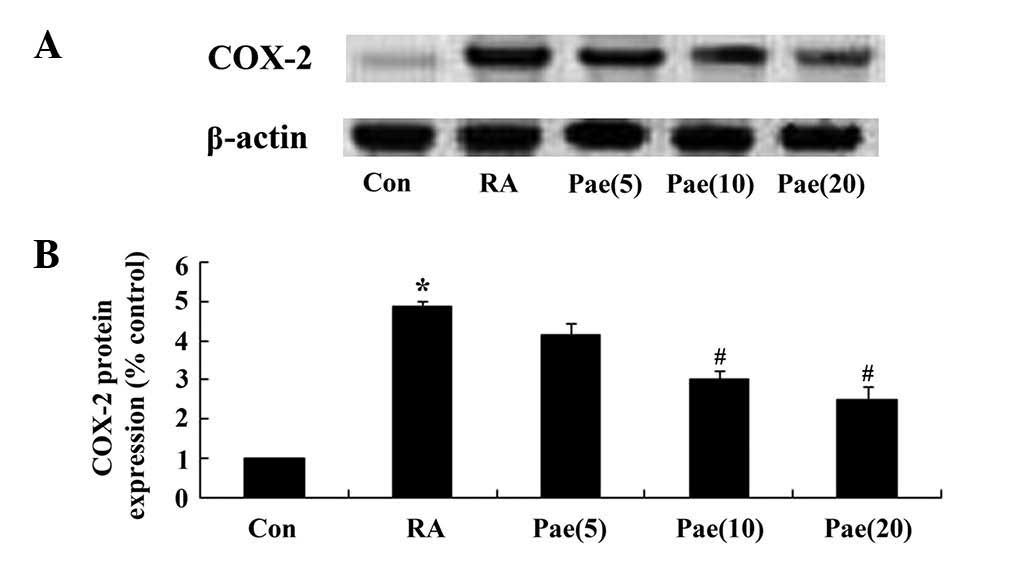Paeoniflorin ameliorates rheumatoid arthritis in rat models through oxidative stress, inflammation and cyclooxygenase 2
- Authors:
- Published online on: December 2, 2015 https://doi.org/10.3892/etm.2015.2908
- Pages: 655-659
Abstract
Introduction
Rheumatoid arthritis (RA) is a systemic disease characterized by progressive synovitis and the degeneration of joints; however, the underlying pathogenesis of RA remains unclear (1). For patients with bone and joint damage caused by RA, the ultimate aim of treatment is to delay the disability of joint function caused by the disease (2). During active periods of RA, the hyperplastic synovial tissue and pannus directly erode articular cartilage and bone tissue surrounding the joints. Inhibiting the proliferation of inflammatory synovial tissue and inducing apoptosis in synovial tissue is therefore the primary aim of RA treatment (3).
Oxidative stress is closely associated with human aging, cardiovascular disease and chronic inflammation, amongst other diseases that have previously been associated with immune dysfunction. A complete antioxidant defense system is well-evolved, and includes antioxidant enzymes, antioxidants and a variety of other mechanisms tasked with damage repair and re-synthesis (4). The coordination and complementation of the various antioxidant defense systems in vivo guarantee their stable and effective involvement in the antioxidative stress effect. At present, the pathogenesis of RA remains to be elucidated, but it has previously been indicated that oxidative stress has an important role in the pathology of the disease (5).
RA is an inflammatory form of arthritis that may be caused by a variety of factors, including genetic or environmental causes and microbial invasion, amongst others. Tumor necrosis factor-α (TNF-α) and interleukin-1β (IL-1β) are pro-inflammatory cytokines that are pivotal in the pathogenesis of RA (6). Cyclooxygenase (COX) is an enzyme necessary for the synthesis of prostaglandins, and a key rate-limiting enzyme in the initial steps of prostaglandin synthesis. In a previous study, COX-1 was suggested not to be directly involved in inflammation (7). However, another study has reported that COX-1 is not only involved in inflammation, but that it also aggravates inflammation, while COX-2 appears to be mainly involved in the early inflammatory processes, but has an anti-inflammatory effect during chronic inflammation (8).
Paeoniflorin is the main active constituent of peonies, used in traditional Chinese medicine, and is a monoterpene glycoside compound. Previous investigations of the pharmacological effects of paeoniflorin have revealed that paeoniflorin has multiple roles, which include the attenuation of free radical damage, the inhibition of intracellular calcium overload and the abrogation of neurotoxicity (9). In vivo experiments indicate that this has numerous biological effects, including a reduction in blood viscosity and platelet aggregation, dilation of blood vessels, improvement of microcirculation, inhibition of oxidation and action as an anti-convulsive, with low toxicity and few side effects (10). However, the mechanisms underlying the protective effects of paeoniflorin upon RA remain unclear. The present study therefore aimed to investigate the delayed protective effects of paeoniflorin in a rat model of RA, and to reveal the signaling pathways involved in the actions of paeoniflorin.
Materials and methods
Experimental rat model
Healthy, male, Sprague-Dawley rats weighing 250–300 g were obtained from the Animal Resource Center of the First Affiliated Hospital of Dalian Medical University (Dalian, China). The rats were maintained in individual cages under standard conditions (12:12-h light-dark cycle, 40–60% humidity and 22–24°C), and provided with food and water ad libitum. All study protocols employed were in accordance with the guidelines of the Animal Care and Use Committee of the First Affiliated Hospital of Dalian Medical University.
Model establishment
The RA rat model was established as described previously (11). The experimental rats were placed in a cage with a fan in a high position (12:12-h light-dark cycle, 80–90% humidity, 4–8°C) for 20 days. On the 21st day of the experiment, rats were anesthetized with an intraperitoneal (i.p.) injection of 50 mg/kg sodium pentobarbital. Freund's complete adjuvant (10 mg/ml; F-5881; Sigma-Aldrich, St. Louis, MO, USA) was injected subcutaneously between the 2nd and 3rd toes of the right foot. The experimental rats were observed for 3 days and the right ankle demonstrated acute inflammatory swelling within 24 h. Secondary, widespread arthritis occurred within 24 h, manifesting in the forelimbs and contralateral limbs as red swellings or inflamed nodes; arthritis also spread to the ear and tail, indicating a successful model.
Grouping and treatment
The experimental rats were randomly divided into 5 groups. In the control (Con; n=8) and RA rat model (RA; n=8) groups, the rats received sodium pentobarbital (10 mg/ml, i.p.), while in the paeoniflorin(5), (10) and (20) groups [Pae(5), Pae(10) and Pae(20), respectively; n=8 in each], the rats were treated with 5, 10 or 20 mg/kg paeoniflorin (i.p.), respectively, all for 3 weeks (12). The chemical structure of paeoniflorin (purity >98%; Nanjing University of Traditional Chinese Medicine, Institute of Chinese Material Medica, Nanjing, China) is indicated in Fig. 1.
Measurement of pain thresholds of the RA rat model
After a 3-week treatment with paeoniflorin, the pressure pain threshold (g) was detected three times each session with an interval of 20 min between sessions, using an electronic pressure pain detector (Somedic AB, Hörby, Sweden), as previously described (13). The mean value was used to indicate the pressure pain threshold.
Clinical arthritic scoring of RA rats
After the 3-week paeoniflorin treatment, the rats were evaluated for arthritis using a macroscopic scoring system, as follows: Severe arthritis of the entire paw and digits, 11–15 points; >2 joints involved, 6–10 points; 2 joints involved, 1–5 points; and no signs of arthritis, 0 points.
Measurement of oxidative stress of RA rats
After the 3-week paeoniflorin treatment, peripheral blood was collected. The blood samples were centrifuged at 3,000 × g for 10 min at 4°C, and were analyzed to detect the concentration of malondialdehyde (MDA) and the activity of superoxide dismutase (SOD), catalase (CAT) and glutathione peroxidase (GSH-Px), following the manufacturer's protocol (Beijing Boaosen Biotechnology, Ltd., Beijing, China).
Measurement of inflammatory effects on RA rats
Peripheral blood samples were processed as aforementioned, and the activity of nuclear factor (NF)-κB p65 unit, TNF-α, IL-1β and IL-6 were analyzed, following the manufacturer's protocol (Beijing Boaosen Biotechnology, Ltd.).
Western blot analysis of COX-2 in RA rats
Following treatment with paeoniflorin for 3 weeks, ~10-mg RA tissue samples were removed and incubated on ice for 30 min with 100 µl tissue lysis buffer. Homogenates were centrifuged at 3,000 × g for 10 min at 4°C and protein concentration was measured using a bicinchoninic acid kit (Fermentas, Beijing, China). Equal protein was loaded onto 12% sodium dodecyl sulfate-polyacrylamide gels and transferred to polyvinylidene fluoride membranes (Millipore, Billerica, MA, USA). The following antibodies were used for the western blot analysis: Monoclonal anti-COX-2 (1:1,000; sc-376861) and anti-β-actin (1:500; sc-7210; Santa Cruz Biotechnology, Inc., Dallas, TX, USA) overnight at 4°C. Membranes were incubated with anti-rabbit immunoglobulin G (IgG) horseradish peroxidase-conjugated secondary antibodies (Santa Cruz Biotechnology, Inc.) at 37°C for 1 h. The relative band intensity was detected using the Amersham ECL Western Blotting Detection kit (GE Healthcare Buchler GmbH & Co. KG, Braunschweig, Germany).
Statistical analysis
Data are expressed as the mean ± standard deviation. Differences in arthritic score were evaluated by Student's t-test, and these were considered significant at P<0.05.
Results
Effect of paeoniflorin on the pain thresholds of the RA rat model
The data in Fig. 2 demonstrates that 3 weeks of RA markedly reduced the pain threshold in the rats when compared with the control group. After the 3-week paeoniflorin treatment, 10 and 20 mg/kg of paeoniflorin were demonstrated to significantly recover the pain thresholds when compared with the RA rats (P<0.01; Fig. 2).
Effect of paeoniflorin on the clinical arthritic score of RA rats
The clinical arthritic score of the RA model rats was markedly increased in comparison to the control group (Fig. 3). Treatment with 20 mg/kg of paeoniflorin significantly decreased the clinical arthritic score at 1, 2 and 3 weeks of treatment when compared with that of the RA rats (P<0.01; Fig. 3). Clinical arthritic score also significantly decreased following treatment with 10 mg/kg paeoniflorin for 2 and 3 weeks when compared with the RA rats (P<0.01; Fig. 3).
Effect of paeoniflorin on the concentration of MDA and the SOD, CAT and GSH-Px activity in RA rats
To elucidate the antioxidant effects of paeoniflorin treatment in the RA model rats, the concentration of MDA, and the SOD, CAT and GSH-Px activity were measured. After the 3-week treatment period, the MDA concentration increased, and SOD, CAT and GSH-Px activity were reduced in the RA rats when compared with the control group (Fig. 4A–D). However, this effect was rescued following treatment with 10 and 20 mg/kg paeoniflorin (Fig. 4A–D).
Effect of paeoniflorin on NF-κB p65 unit, TNF-α, IL-1β and IL-6 activity in RA rats
To elucidate the anti-inflammatory effects of paeoniflorin treatment in RA rats, NF-κB p65 unit, TNF-α, IL-1β and IL-6 activity were analyzed; activity was found to be significantly increased when compared with the control group (Fig. 5A–D). After a 3-week treatment with paeoniflorin (10 and 20 mg/kg), NF-κB p65 unit, TNF-α, IL-1β and IL-6 activity was reduced in comparison with that of the RA rats (P<0.01; Fig. 5A–D).
Effect of paeoniflorin on COX-2 in RA rats
As COX-2 has crucial roles in inflammation, the regulatory effects of paeoniflorin on the inflammatory response in the RA rats was examined. COX-2 protein expression was elevated in the RA rats compared with that of the control group (Fig. 6). Notably, paeoniflorin administration at 10 and 20 mg/kg significantly reduced COX-2 protein expression in the RA rat model (P<0.01; Fig. 6).
Discussion
RA is a symmetrical, chronic inflammatory disease primarily affecting multiple small peripheral joints, with possible extra-articular systemic damage (14). RA patients may suffer from pain, numbness, weight gain, difficulty in joint flexion and extension, joint swelling and a burning sensation in the muscles, bones and joints (15). In the present study, paeoniflorin significantly improved pain thresholds and reduced arthritic symptoms in an RA rat model. This is consistent with the results of a previous study by Zheng et al, which indicated that paeoniflorin suppressed arthritis in a rat model through its effects on synoviocytes, and by reducing COX-2 expression in the synovium (12). Paeoniflorin may therefore represent a potential therapeutic agent for the treatment of RA.
Within a normal mammalian body, the production and clearance of active oxygen are in a state of dynamic equilibrium. When the antioxidant system is dysfunctional, excessive accumulation of reactive oxygen species and associated metabolites occurs, causing tissue damage (16,17). Previous studies have indicated that oxidative stress and RA are associated with elevated serum levels of lipid peroxidation reactant, a reduced level of SOD and the abnormal activity of antioxidant enzymes (18). In the present study, treatment with paeoniflorin decreased the MDA concentration and increased the SOD, CAT and GSH-Px activity in rats with RA. Similarly, Wankun et al demonstrated that paeoniflorin induces cellular apoptosis and protects ARPE-19 cells through repression of oxidative stress (19), and Zhao et al revealed that paeoniflorin protects against α-naphthylisothiocyanate-induced cholestasis by ameliorating oxidative stress in rats (20).
Collagen-induced arthritis is primarily characterized by an early local inflammatory reaction, and secondary lesions are manifested as contralateral hindlimb and forelimb swellings. When the synovial macrophages of RA patients are activated, the overexpression of inflammatory cytokines (including IL-1β and TNF-α), chemokines (including IL-8 and macrophage inflammatory protein-1) and matrix metalloproteinases follows (21). The symptoms and degree of joint damage in RA are closely associated with the number of macrophages present, and with the levels of IL-1β and TNF-α (22). TNF-α induces endothelial cells to express adhesion molecules, and to promote leukocyte endothelial adhesion and tissue infiltration, resulting in local inflammation. In addition, TNF-α is able to promote cartilage cells to secrete plasminogen activator, transforming plasminogen into plasmin and thus accelerating arthritic damage. Furthermore, TNF-α can also induce synovial cells, macrophages, fibroblasts and chondrocytes to secrete IL-1 and IL-8, which increases tissue damage (23). The present study similarly demonstrated that paeoniflorin modulated the activity of NF-κB p65 unit, TNF-α, IL-1β and IL-6 in the RA rat model. In previous associated studies, paeoniflorin induced anti-inflammatory effects in asthmatic mice (24) and inhibited the inflammatory response in mice presenting with allergic contact dermatitis (25).
COX-2 is an inducible chemical enzyme that is not typically expressed in numerous tissues (26). When the body is stimulated by proinflammatory cytokines, certain cells, including endothelial cells, vascular smooth muscle cells, monocytes macrophages and fibroblasts, are induced to express COX-2, such that COX-2 protein levels are rapidly upregulated between 8- and 10-fold. COX-2 overexpression induces the synthesis and accumulation of prostaglandins, the inflammatory cytokines, in the damaged tissues, and promotes local inflammation and tissue damage (27). Overexpression of COX-2 can also promote cell proliferation, and inhibit apoptosis and the immune response, thereby evading immune surveillance, finally resulting in disruption of the balance between cell proliferation and apoptosis (28). In the current study, paeoniflorin significantly inhibited COX-2 protein expression. Similarly, a previous study also reported that paeoniflorin suppressed arthritis in a rat model by reducing COX-2 expression in the synovium (12), and another study revealed that paeoniflorin protected against ischemia-induced brain damage by inhibiting COX-2-mediated activity in rats (29).
In conclusion, the present findings demonstrate that the protective effect of paeoniflorin in RA treatment may occur through anti-oxidative and anti-inflammatory effects, and through the suppression of COX-2. Paeoniflorin may thus be considered a potential therapeutic agent in the treatment of RA, but more in-depth study is required to fully elucidate its mechanism and clinical effects.
Acknowledgements
The present study was supported by grants from the Research Foundation of Dalian Technology Bureau, China (grant no. 2012E15SF166) and Liaoning Province Science and Technology Plan Projects (grant no. 2013225002).
Glossary
Abbreviations
Abbreviations:
|
RA |
rheumatoid arthritis |
|
COX |
cyclooxygenase |
|
MDA |
malondialdehyde |
|
SOD |
superoxide dismutase |
|
CAT |
catalase |
|
GSH-Px |
glutathione peroxidase |
|
TNF-α |
tumor necrosis factor-α |
|
IL |
interleukin |
References
|
Dhaouadi T, Sfar I, Abelmoula L, Jendoubi-Ayed S, Aouadi H, Ben Abdellah T, Ayed K, Zouari R and Gorgi Y: Role of immune system, apoptosis and angiogenesis in pathogenesis of rheumatoid arthritis and joint destruction, a systematic review. Tunis Med. 85:991–998. 2007.PubMed/NCBI | |
|
Wang K, Zhao L, Liu X, Hao Z, Zhou Y, Yang C and Li H: Differential co-expression analysis of rheumatoid arthritis with microarray data. Mol Med Rep. 10:2421–2426. 2014.PubMed/NCBI | |
|
Liu H and Pope RM: The role of apoptosis in rheumatoid arthritis. Curr Opin Pharmacol. 3:317–322. 2003. View Article : Google Scholar : PubMed/NCBI | |
|
Radhakrishnan A, Tudawe D, Chakravarthi S, Chiew GS and Haleagrahara N: Effect of γ-tocotrienol in counteracting oxidative stress and joint damage in collagen-induced arthritis in rats. Exp Ther Med. 7:1408–1414. 2014.PubMed/NCBI | |
|
Shahmohamadnejad S, Vaisi-Raygani A, Shakiba Y, Kiani A, Rahimi Z, Bahrehmand F, Shakiba E and Pourmotabbed T: Association between butyrylcholinesterase activity and phenotypes, paraoxonase192 rs662 gene polymorphism and their enzymatic activity with severity of rheumatoid arthritis, Correlation with systemic inflammatory markers and oxidative stress, preliminary report. Clin Biochem. 48:63–69. 2015. View Article : Google Scholar : PubMed/NCBI | |
|
Lu QY, Han QH, Li X, Li ZC, Pan YT, Liu L and Fu QG: Analysis of differentially expressed genes between rheumatoid arthritis and osteoarthritis based on the gene co-expression network. Mol Med Rep. 10:119–124. 2014.PubMed/NCBI | |
|
Mederle K, Meurer M, Castrop H and Hocherl K: Inhibition of COX-1 attenuates the formation of thromboxane A2 and ameliorates the acute decrease in glomerular filtration rate in endotoxemic mice. Am J Physiol Renal Physiol. 309:F332–F340. 2015. View Article : Google Scholar : PubMed/NCBI | |
|
Choi YJ, Lee WS, Lee EG, Sung MS and Yoo WH: Sulforaphane inhibits IL-1β-induced proliferation of rheumatoid arthritis synovial fibroblasts and the production of MMPs, COX-2, and PGE2. Inflammation. 37:1496–1503. 2014. View Article : Google Scholar : PubMed/NCBI | |
|
Dong H, Li R, Yu C, Xu T, Zhang X and Dong M: Paeoniflorin inhibition of 6-hydroxydopamine-induced apoptosis in PC12 cells via suppressing reactive oxygen species-mediated PKCδ/NF-κB pathway. Neuroscience. 285:70–80. 2015. View Article : Google Scholar : PubMed/NCBI | |
|
Choi EM, Suh KS, Rhee SY and Kim YS: Inhibitory effect of paeoniflorin on methylglyoxal-mediated oxidative stress in osteoblastic MC3T3-E1 cells. Phytomedicine. 21:1170–1177. 2014. View Article : Google Scholar : PubMed/NCBI | |
|
Luo L, Hu L, He L, Tang ZL, Song XG, Dirckinck-Holmfeld L and Cai RL: Effect of moxibustion on ultrastructure of synovial cells in rheumatoid arthritis rats. Zhen Ci Yan Jiu. 36:105–109. 2011.(In Chinese). PubMed/NCBI | |
|
Zheng YQ, Wei W, Zhu L and Liu JX: Effects and mechanisms of Paeoniflorin, a bioactive glucoside from peony root, on adjuvant arthritis in rats. Inflamm Res. 56:182–188. 2007. View Article : Google Scholar : PubMed/NCBI | |
|
Zheng B, Hu L, Song X, Wu Z, Cai R, He L, Zhang C and Yu Q: Analgesic effect of different moxibustion durations in rheumatoid arthritis rats. J Tradit Chin Med. 34:90–95. 2014. View Article : Google Scholar : PubMed/NCBI | |
|
Zheng G, Wang L, Jia X, Li F, Yan Y, Yu Z, Li L, Wei Q and Zhang F: Application of high frequency color Doppler ultrasound in the monitoring of rheumatoid arthritis treatment. Exp Ther Med. 8:1807–1812. 2014.PubMed/NCBI | |
|
Almoallim HM and Alharbi LA: Rheumatoid arthritis in Saudi Arabia. Saudi Med J. 35:1442–1454. 2014.PubMed/NCBI | |
|
Baldeiras I, Santana I, Proença MT, Garrucho MH, Pascoal R, Rodrigues A, Duro D and Oliveira CR: Peripheral oxidative damage in mild cognitive impairment and mild Alzheimer's disease. J Alzheimers Dis. 15:117–128. 2008.PubMed/NCBI | |
|
Hitchon CA and El-Gabalawy HS: Oxidation in rheumatoid arthritis. Arthritis Res Ther. 6:265–278. 2004. View Article : Google Scholar : PubMed/NCBI | |
|
Toyokuni S: Molecular mechanisms of oxidative stress-induced carcinogenesis: F rom epidemiology to oxygenomics. IUBMB Life. 60:441–447. 2008. View Article : Google Scholar : PubMed/NCBI | |
|
Wankun X, Wenzhen Y, Min Z, Weiyan Z, Huan C, Wei D, Lvzhen H, Xu Y and Xiaoxin L: Protective effect of paeoniflorin against oxidative stress in human retinal pigment epithelium in vitro. Mol Vis. 17:3512–3522. 2011.PubMed/NCBI | |
|
Zhao Y, Zhou G, Wang J, Jia L, Zhang P, Li R, Shan L, Liu B, Song X, Liu S and Xiao X: Paeoniflorin protects against ANIT-induced cholestasis by ameliorating oxidative stress in rats. Food Chem Toxicol. 58:242–248. 2013. View Article : Google Scholar : PubMed/NCBI | |
|
Klein K, Kabala PA and Grabiec AM: The bromodomain protein inhibitor I-BET151 suppresses expression of inflammatory genes and matrix degrading enzymes in rheumatoid arthritis synovial fibroblasts. Ann Rheum Dis Dec. 2:2014.(Epub ahead of print). | |
|
Ichihara H, Yamasaki S, Hino M, Ueoka R and Matsumoto Y: Therapeutic effects of hybrid liposomes with downregulation of inflammatory cytokine for model mice of rheumatoid arthritis in vivo. Bioorg Med Chem Lett. 25:2686–2689. 2015. View Article : Google Scholar : PubMed/NCBI | |
|
Zhang J, Chen L, Delzell E, Muntner P, Hillegass WB, Safford MM, Millan IY, Crowson CS and Curtis JR: Republished: The association between inflammatory markers, serum lipids and the risk of cardiovascular events in patients with rheumatoid arthritis. Postgrad Med J. 90:722–729. 2014. View Article : Google Scholar : PubMed/NCBI | |
|
Sun J, Wu J, Xu C, Luo Q, Li B and Dong J: Paeoniflorin attenuates allergic inflammation in asthmatic mice. Int Immunopharmacol. 24:88–94. 2015. View Article : Google Scholar : PubMed/NCBI | |
|
Wang C, Yuan J, Wu HX, Chang Y, Wang QT, Wu YJ, Liu LH and Wei W: Paeoniflorin inhibits inflammatory responses in mice with allergic contact dermatitis by regulating the balance between inflammatory and anti-inflammatory cytokines. Inflamm Res. 62:1035–1044. 2013. View Article : Google Scholar : PubMed/NCBI | |
|
Yoon HY, Lee EG, Lee H, Cho IJ, Choi YJ, Sung MS, Yoo HG and Yoo WH: Kaempferol inhibits IL-1β-induced proliferation of rheumatoid arthritis synovial fibroblasts and the production of COX-2, PGE2 and MMPs. Int J Mol Med. 32:971–977. 2013.PubMed/NCBI | |
|
Dubois RN, Abramson SB, Crofford L, Gupta RA and Simon LS: VanD e Putte LB and Lipsky PE: Cyclooxygenase in biology and disease. FASEB J. 12:1063–1073. 1998.PubMed/NCBI | |
|
Markosyan N, Chen EP, Evans RA, Ndong V, Vonderheide RH and Smyth EM: Mammary carcinoma cell derived cyclooxygenase 2 suppresses tumor immune surveillance by enhancing intratumoral immune checkpoint activity. Breast Cancer Res. 15:R752013. View Article : Google Scholar : PubMed/NCBI | |
|
Guo RB, Wang GF, Zhao AP, Gu J, Sun XL and Hu G: Paeoniflorin protects against ischemia-induced brain damages in rats via inhibiting MAPKs/NF-κB-mediated inflammatory responses. PLoS One. 7:e497012012. View Article : Google Scholar : PubMed/NCBI |



